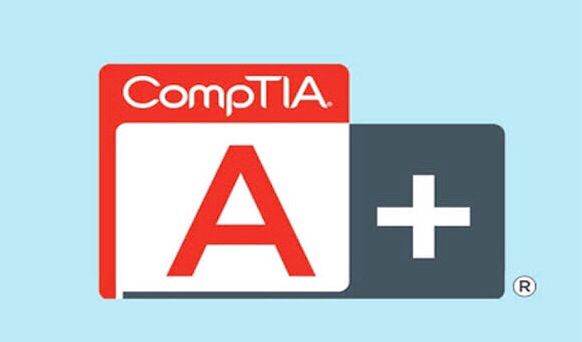
CompTIA: A+ (hardware, os & basic networking)
.CompTIA: A+ 220-1001 covers mobile devices, networking technology, hardware, virtualization and cloud computing and network troubleshooting.
CompTIA A+ 220-1002 covers installing and configuring
operating systems, expanded security, software troubleshooting and operational procedures.
Exam Details
Exam Codes CompTIA A+ 220-1001 (Core 1) and 220-1002 (Core 2)
Candidates must complete both 1001 and 1002 to earn certification. Exams
cannot be combined across the series.
Launch Date January 15, 2019
Exam Description CompTIA A+ 220-1001 covers mobile devices, networking technology,
hardware, virtualization and cloud computing and network troubleshooting.
CompTIA A+ 220-1002 covers installing and configuring operating systems,
expanded security, software troubleshooting and operational procedures.
Number of
Questions
Maximum of 90 questions per exam
Type of Questions Multiple choice questions (single and multiple responses), drag and drops
and performance-based
Length of Test 90 Minutes per exam
Passing Score 220-1001: 675 (on a scale of 100-900)
220-1002: 700 (on a scale of 100-900)
Recommended
Experience
9 to 12 months of hands-on experience in the lab or field
Languages English at launch. German, Japanese, Portuguese, Thai and Spanish
Retirement TBD - Usually three years after launch
Testing Provider Pearson VUE
• Testing Centers
• Online Testing
Course Objectives
In this course, you will install, configure, optimize, troubleshoot, repair, upgrade, and perform
preventive maintenance on personal computers and digital devices. You will:
Install and configure PC system unit components and peripheral devices.
Install, configure, and troubleshoot display and multimedia devices.
Install, configure, and troubleshoot storage devices.
Install, configure, and troubleshoot internal system components.
Explain network infrastructure concepts.
Configure and troubleshoot network connections.
Implement client virtualization and cloud computing.
Support and troubleshoot laptops.
Support and troubleshoot mobile devices.
Install, configure, and troubleshoot print devices
COURSE OUTLINE
1 - INSTALLING AND CONFIGURING PC COMPONENTS
• Use Appropriate Safety Procedures
• PC Components
• Common Connection Interfaces
• Install Peripheral Devices
2 - INSTALLING, CONFIGURING, AND TROUBLESHOOTING DISPLAY AND
MULTIMEDIA DEVICES
• Install and Configure Display Devices
• Troubleshoot Display Devices
• Install and Configure Multimedia Devices
3 - INSTALLING, CONFIGURING, AND TROUBLESHOOTING STORAGE DEVICES
• Install System Memory
• Install and Configure Mass Storage Devices
• Install and Configure Removable Storage
• Configure RAID
• Troubleshoot Storage Devices
4 - INSTALLING, CONFIGURING, AND TROUBLESHOOTING INTERNAL SYSTEM
COMPONENTS
• Install and Upgrade CPUs
• Configure and Update BIOS/UEFI
• Install Power Supplies
• Troubleshoot Internal System Components
• Configure a Custom PC
5 - INSTALLING, CONFIGURING, AND TROUBLESHOOTING PRINT DEVICES
• Maintain Laser Printers
• Maintain Inkjet Printers
• Maintain Impact, Thermal, and 3D Printers
• Install and Configure Printers
• Troubleshoot Print Device Issues
• Install and Configure Imaging Devices
6 - NETWORK INFRASTRUCTURE CONCEPTS
• Wired Networks
• Network Hardware Devices
• Wireless Networks
• Internet Connection Types
• Network Configuration Concepts
• Network Services
7 - CONFIGURING AND TROUBLESHOOTING NETWORKS
• Configure Network Connection Settings
• Install and Configure SOHO Networks
• Configure SOHO Network Security
• Configure Remote Access
• Troubleshoot Network Connections
• Install and Configure IoT Devices
8 - SUPPORTING AND TROUBLESHOOTING LAPTOPS
• Use Laptop Features
• Install and Configure Laptop Hardware
• Troubleshoot Common Laptop Issues
9 - SUPPORTING AND TROUBLESHOOTING MOBILE DEVICES
• Mobile Device Types
• Connect and Configure Mobile Device Accessories
• Configure Mobile Device Network Connectivity
• Support Mobile Apps
• Secure Mobile Devices
• Troubleshoot Mobile Device Issues
10 - IMPLEMENTING CLIENT VIRTUALIZATION AND CLOUD COMPUTING
• Configure Client-Side Virtualization
• Cloud Computing Concepts
11 - SUPPORTING OPERATING SYSTEMS
• Identify Common Operating Systems
• Troubleshooting Methodology
• Use Windows Features and Tools
• Manage Files in Windows
• Manage Disks in Windows
• Manage Devices in Windows
12 - MAINTAINING AND TROUBLESHOOTING MICROSOFT WINDOWS
• Install and Manage Windows Applications
• Manage Windows Performance
• Troubleshoot Windows
13 - INSTALLING, CONFIGURING, AND MAINTAINING OPERATING SYSTEMS
• Configure and Use Linux
• Configure and Use macOS
• Install and Upgrade Operating Systems
• Maintain Oss
14 - MANAGING USERS, WORKSTATIONS, AND SHARED RESOURCES
• Manage Users
• Configure Shared Resources
• Configure Active Directory Accounts and Policies
15 - SECURITY CONCEPTS
• Logical Security Concepts
• Threats and Vulnerabilities
• Physical Security Measures
16 - SECURING WORKSTATIONS AND DATA
• Implement Security Best Practices
• Implement Data Protection Policies
• Protect Data During Incident Response
17 - TROUBLESHOOTING WORKSTATION SECURITY ISSUES
• Detect, Remove, and Prevent Malware
• Troubleshoot Common Workstation Security Issues
18 - IMPLEMENTING OPERATIONAL PROCEDURES
• Environmental Impacts and Controls
• Create and Maintain Documentation
• Use Basic Change Management Best Practices
• Implement Disaster Prevention and Recovery Methods
• Basic Scripting Concepts
• Professionalism and Communication
